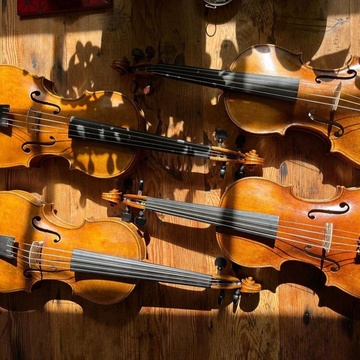
- This event has passed.
The Rosary Sonatas of Heinrich Biber – A Summer Fundraiser for a New Violin
Sunday, July 23, 2023, 3:30 pm - 6:30 pm
$60Tesserae violinist Andrew McIntosh is joined by Maxine Eilander (Baroque harp) and Ian Pritchard (organ and harpsichord) for a rare complete performance of Heinrich Biber’s Rosary Sonatas.The performance will be held at the stunning Villa del Sol d’Oro, where audience members will be able to enjoy wine and cookies while perusing the lush grounds of this historic building.
This event is raising funds for Andrew’s new Baroque violin. Tickets are $60, with an option to add a donation. All donations and ticketing revenue will go directly towards the new instrument. If you prefer to pay at the door, please reach out to alex@tesseraebaroque.org, and we will reserve your seat.
PURCHASE TICKETS/MAKE A DONATION
A note from Andrew
My personal gateway drug to baroque music was the Rosary Sonatas of Heinrich Biber. Composed around 1675, these fifteen magnificent pieces evoke the entire range of human experience, from the tender and sublime to outrage and triumph, and follow the story of the life of Christ, as depicted in copper plate engravings at the beginning of each sonata.
Radically virtuosic and experimental, each sonata features a different tuning on the open strings of the violin, creating unique resonances and timbres that are matched individually to the characters portrayed in each sonata. The tunings with the most tension and the strangest resonances are used in pieces that depict pain and suffering, while those depicting reverence or joy have more open and bell-like tunings.
In the sonata depicting the descent of the Holy Spirit, for instance, the violin is tuned to an open chord that isn’t even in the same key as the piece, giving the whole work a ghostly character by making unresolved harmonies ring. In the sonata depicting the resurrection, the two middle strings of the instrument are crossed in the peg box and behind the bridge. Not only do they literally depict a cross on the instrument, they also don’t go in order from low to high, lending the music frequent giant leaps and large intervals that wouldn’t normally be possible.
Of course, none of this experimentation would be exciting if it weren’t for the fact that the pieces are absolutely sublime and follow a massive narrative arc from beginning to end through the kaleidoscope of tunings.
Stories about Biber abound in colorful anecdotes. For instance, he supposedly accompanied himself by playing the bass line on the foot pedals of an organ while playing the treble part on the violin. Another anecdote is that he traveled to Austria, at the request of his employer in Hungary, to pick up an order of violins made by Jacob Stainer. However, while on the trip he decided to take a new job in Salzburg and never returned!
He continued to maintain a relationship with Stainer, who lived nearby, and likely played on Stainer violins for most of his career. Stainer violins today are not all that well-known, but at the time Stainer was considered one of the premiere violin makers in Europe. In fact, in the 18th century a Stainer violin cost four times the price of a Stradivarius, and J.S. Bach, Francesco Geminiani, Giuseppe Tartini, and Leopold Mozart all played on Stainer violins. It’s been a dream of mine for many years to perform Biber’s Rosary sonatas on Stainer model violins, which have a distinct shape and character.
Here in Los Angeles we happen to have a marvelous German luthier who is an expert on the violins of Jacob Stainer, by the name of Michael Fischer. Michael’s instruments are well-respected around the world, and if you attend an LA Phil concert you will hear several of them on stage. He is particularly known for his exquisite and meticulous copies of rare old instruments by makers such as Stradivarius and Maggini, and his instruments have a reputation for sounding “old”, even though they are new.
Several years ago I commissioned him to make a baroque violin, copying an original by Jacob Stainer. Earlier this year he completed not one but four of them, modeled after three different original Stainers. For this performance of the Rosary Sonatas I’ll be rotating through all four of Michael’s new Stainer model baroque violins. Your donations at this fundraiser will go toward the cost of the commission.
The fifteen Rosary sonatas are divided into three sections, each lasting around 40 minutes: the joyful mysteries, the sorrowful mysteries, and the glorious mysteries. The performance will have two intermissions, during which guests can wander the garden and have refreshments. I’m delighted to be joined by Maxine and Ian on this enterprise, and very grateful to Tesserae for hosting the event!
© 2024 · Tesseræ


